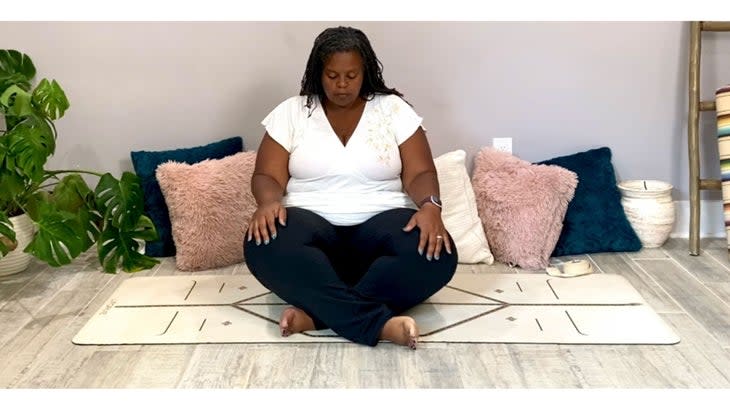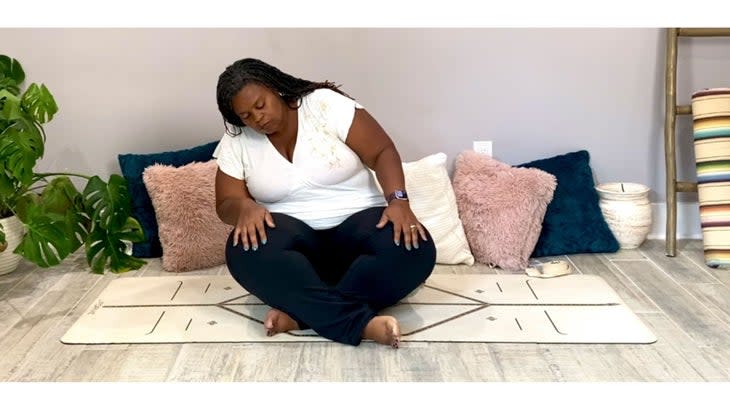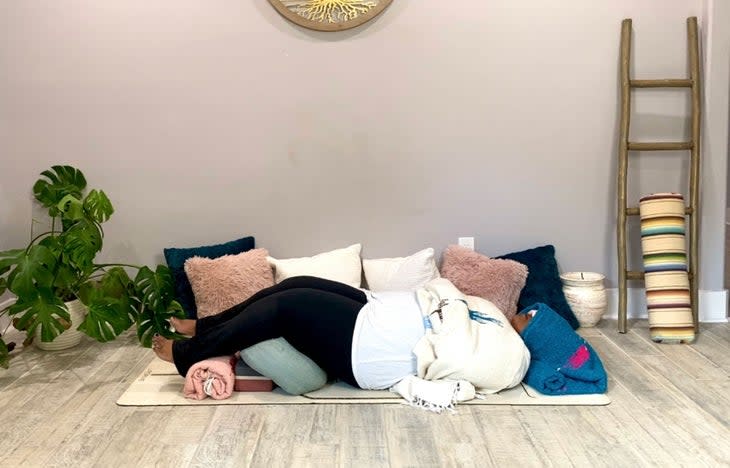A Trauma-Informed Yoga Practice to Cultivate Inner Peace
This article originally appeared on Yoga Journal
Give yourself a break. Even when it feels like you're merely hiding from the world, tucked under a blanket on the couch watching your favorite rom-com, your nervous system is actually doing its job. All day long, it processes a roller coaster of stress and emotions, and helps us cope with life's ups and downs.
Or it tries. What happens when anxiety and worry stays switched on? What if there's more going on beyond these everyday stressors?
Living in the 21st century means exposing ourselves to one stressor after another, from the latest tragedy in the news to worrying amid the turmoil of a worldwide pandemic. Research tells us that our "issues live in our tissues" and that our body can hold trauma for decades.
Resourcing, or finding a tool that helps us transition out of a dysregulated state is what we can gain from trauma-informe practices. These "resources" rely on breathwork, grounding, and other methods for centering that help us come back to a regulated, easeful state of being. A restorative yoga session draws on several of these resources and can sometimes help us come back a place of calm.
A trauma-informed yoga practice to cultivate inner peace
Try this practice sometime when you're feeling overwhelmed. Return to it as a resource whenever you need.
Video loading...
Bring yourself to your sanctuary
Come to your favorite practice space. Take a look around and notice any beloved decor or soothing details surrounding you. If your eyes land somewhere that you want to fix or change, simply move beyond that and bring your awareness to another object, anything that makes that space a sanctuary for you.
When something of interest catches your eye, let your gaze, or drishti, linger on that object. Perhaps silently say what you find intriguing about the object. Close your eyes or lower your gaze and visualize the object. Know that some aspect of the object’s properties exists within you.

Feel grounded
With your eyes still closed or lowered, bring the peace fingers (index and middle fingers) of both hands to the ground alongside you. This is bhu mudra, a gesture that signifies our connection to the Earth. Begin to sense the connection between your seat and the ground. Go beyond the feeling of the mat or the floor. Sense a connection to the actual Earth beneath you. Allow for your fingers to act as antennae connecting you into Earth's intelligence. Become aware of all of the ancestors of the land you're on and your own ancestors who have become a part of the earth's wisdom. As you inhale, draw up ease, peace, and calm. As you exhale, allow for her to receive your thoughts with gratitude. I like to tell Mother Earth that I will give back to her when I have more resources--and I remember to take time later to plant something beautiful.

Fall into the rhythm of your breath
With closed or lowered eyes, bring awareness to your breath. Inhale with ease for as long as feels comfortable. Let yourself exhale for as long as feels comfortable. Notice the rhythm of your breath without forcing or changing it. Are your inhales and exhales even? Is one longer than the other? Bring an evenness to your inhalations and your exhalations for Sama Vritti Pranayama (Box Breathing). If it feels right in your body, add a tiny pause after your inhalation, then elongate your exhale. Find whatever rhythm of breath that feels supportive to you at this moment.
Hug yourself
Wrap your right arm around the middle of your torso and bring your right hand to your left side ribs. Wrap your left arm around the top of your torso, just above your right, and bring your left hand to your right upper arm. Feel the connection between your hands and body. Allow your head to be heavy.

Hug Yourself with Neck Release
If you like, give yourself a gentle squeeze or lean your head to one side.

Sukhasana to shift energy
Cross your right shin in front of your left to come into Sukhasana (Easy Pose). Begin to rotate your torso around in slow circles slowly and in gentle exploration, initiating movement from your hips. Notice any “sticky” places in and around your hips, side body, or neck. Bring awareness to these places with compassion as you continue to rotate in these large circles. Repeat about 8 rotations.

Place your right hand on the floor or on a block about a foot away from your right hip. Extend your left arm up alongside your left ear. Press into the floor as you elongate your left side body into a side bend. Press and reach, noticing the connection to the floor while opening along your left side. Look up to your left fingertips and follow them around as you wrap your left arm behind your body. Draw your left shoulder back, rotate your chest towards the sky, and look up to a point on the ceiling. Let your right ear come towards your right shoulder for neck release. Breathe.
Release the bind and uncross your legs. Bounce them out or shake them out. Then, cross your legs, with your left leg in front of the right. Repeat all of these movements on the left side.

Practice rest
Prepare to create a nest or cocoon for yourself in a supported Savasana. Give yourself darkness, quiet, and warmth to facilitate conscious rest. You may give yourself support beneath your head, neck, knees, and ankles with whatever pillows, bolsters, or blankets that you have on hand. I prefer to make a small roll underneath my neck with a blanket and then bring the remaining part of the blanket over my eyes as an easy way to darken the room and create comfort. Nesting your arms in blankets tucked beneath the sides of your body can create a lovely sense of containment. You may also enjoy a blanket over your navel center. Support every nook and cranny of your body--fill in any spaces in which your body is floating above the ground with a blanket, pillow, or bolster. I suggest you set timer to enjoy this supported Savasana for 15 minutes.
When you’re ready, slowly start to come back to your breath and to subtle movement. When you are ready to return to life, may you find peace, ease, and calm whenever you need it, and may that peace ripple out into the world.
About our contributor
Tamika Caston-Miller, E-RYT 500, is the director of Ashe Yoga where she curates yoga experiences and trainings in service of collective healing and community repair. Having begun her yoga journey in 2001 with a home practice, she now holds advanced certifications and training in Trauma-informed Yoga, Somatics, Yin Yoga, Restorative Yoga, and Yoga Nidra. Tamika's journey has been informed by chronic pain and injuries, social justice for QTBIPOC communities, the battle between shame and compassion and quest for ancestral healing, and the love for the practice and philosophy of yoga.
See also: More yoga practices from Tamika Caston-Miller
For exclusive access to all of our fitness, gear, adventure, and travel stories, plus discounts on trips, events, and gear, sign up for Outside+ today.
